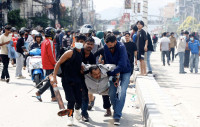Opinion
Women at work
KP Oli could have made significant strides in making the NRA gender-inclusive
Basundhara Bhattarai
A couple of months ago, I watched a speech of Prime Minister KP Sharma Oli, who expressed dissatisfaction over the highly imbalanced representation of women in government services. “We cannot manoeuvre the rule of bureaucracy to increase the number of women in senior posts overnight. Although I am very supportive of this change, it will take time to achieve it”, he said. But has he walked the talk when he got the chance to make a difference?
No, he has not. At least in the formation of the National Reconstruction Authority (NRA), the recently-formed apex body to oversee post-quake reconstruction, he had the opportunity to make a difference. He could have made significant strides in making the NRA gender-inclusive. Of a total of 95 members in the Central Reconstruction Advisory Council, only two are women. Despite his public commitment, Oli failed to ensure gender equality in this Council.
This discrepancy between talk and deed signifies something quite fundamental. At a time when the disaster recovery is high on the agenda, the gender issue is particularly disregarded. But why does even the prime minister fail to translate his commitment on gender-based inclusion into public policy? There are of course a number of structural, institutional, dispositional and cognitive reasons that prevent gender-inclusive changes in Nepal, and the current disaster response is not free from this chronic ailment. But if we fail to address gender concerns in government offices, the consequences could be irreparable. As men and women are exposed differently to quake impacts, the recovery works may fail to deliver the desired outcomes if women officials are absent in the post-quake rehabilitation.
Women victims
The sense of gender has not remained totally ignored in the way public agencies think and act. The government has subdivided the number of casualties into different genders. Such disaggregated data show that the death toll of women due to the twin earthquakes was eight percent higher than that of men’s, and that women lost more of their home-based enterprises and livelihoods than men did. There could be more of such analysis, but these two facts point to an important conclusion: Gender disaggregated data can help ensure mainstreaming of gender equality and women’s empowerment in a humanitarian response.
Moreover, disaster studies across the world show that women are differently exposed to earthquake risks and that there is a huge diversity within women when it comes to experiencing and coping with the impacts. Just take the example of how pregnant women might find themselves helpless when they have to run away from collapsing buildings during an earthquake. This applies to the recovery work as well. In the recovery stage, reports show increased rates of sexual violence against women.
While conducting rescue operations and distributing immediate relief, we observed numerous voices and reports that the rescue operations and relief distribution were not gender sensitive. Given the existing evidence and public concerns, one could expect such gaps being addressed in the long-term recovery planning and field actions, but unfortunately the government keeps dispelling the concerns of women.
Balancing gender in the recovery stage is particularly important in view of the massive male out-migration in Nepal. In fact, studies reported higher migration from earthquake affected districts than from elsewhere. As a result, the number of women-headed households has increased.
Gender matters
But it is frustrating that the government decisions are not based on the gender disaggregated data, just as there is little congruence between what the prime minister says in public and what his office actually does. The NRA members are ex-officio members such as former prime ministers, finance ministers or vice chairs of the National Planning Commission (NPC)—sectors where women are underrepresented. To make matters worse, the Central Reconstruction Advisory Council has been formed at a time when the Ministry of Women, Children and Social Welfare is headed by a male minister.
In a recent article, Bimala Rai-Paudyal has also highlighted the gender blindness in the formation of the NRA. As an outgoing member of the NPC and one of the members involved in Post Disaster Needs Assessment, Paudyal’s observation makes a lot of sense. At a more fundamental level, having less than two percent women in the NRA is against Nepal’s constitution that reserves at least 33 percent of seats for women. I reiterate numbers are not the solution, but they do indicate our underlying mindset.
The central point I am trying to make here is how gender-exclusive strategies such as the one found in executive decision-making bodies of the NRA can overlook and even undermine specific concerns of different categories of women in a patriarchal society.
Gender talk is itself not new in Nepal. We have seen decades of gender sensitisation, women empowerment and gender mainstreaming. What we need is public accountability of the government that helps to establish gender equality in households, communities and public and private spheres. I am still not sure when Nepal’s public institutions will begin to ‘walk the talk’.
Bhattarai is a gender and development expert [email protected]




 19.12°C Kathmandu
19.12°C Kathmandu










